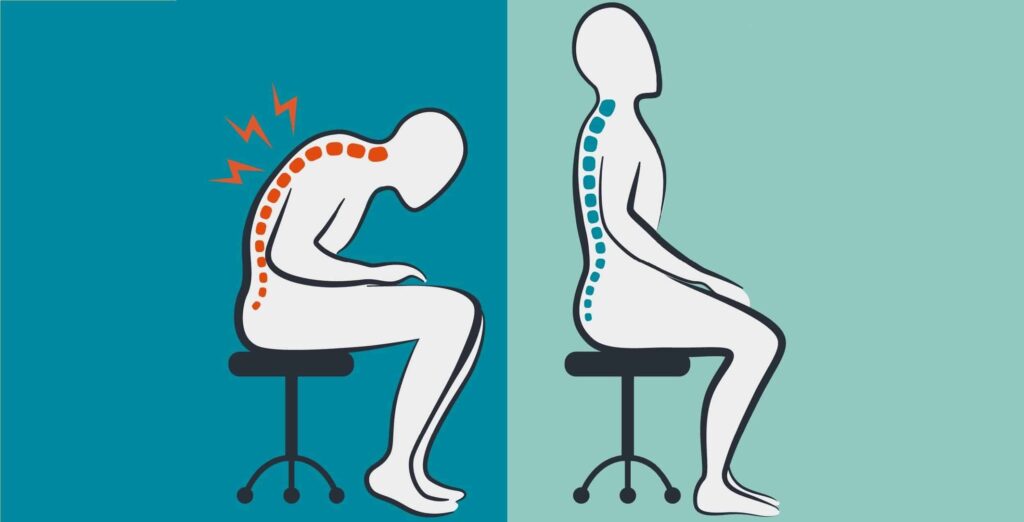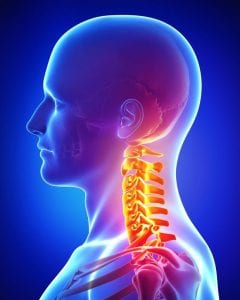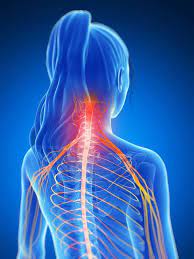

Ever wondered if your neck woes are rooted deep in your DNA?
Buckle up as I dive into the fascinating world where genetics meets posture, unraveling how inheritance can play a pivotal role in neck postural problems.
In This Article:
1) The Genetic Backbone of Your Posture
2) Understanding the Basics: Mendelian Heredity and Posture
3) Hereditary Diseases and Neck Posture
4) The Role of Muscle and Skeletal Structure in Genetic Posture Issues
5) Environmental Factors vs. Genetic Predisposition
6) Scientific Insights: Research Linking Genetics to Posture
7) Real-Life Examples: When Genes Meet Everyday Life
8) Mitigating Genetic Postural Issues: Strategies and Solutions
9) Is Genetics a Key Player in Neck Posture?
The Genetic Backbone of Your Posture
Neck postural problems, often dismissed as mere lifestyle issues, might have a surprising genetic twist.
In this article, I shall explore the intricate relationship between inheritance and neck posture, shedding light on how your genes can predispose you to these challenges.
From understanding basic genetic principles to examining specific hereditary diseases that impact posture, I will navigate through scientific insights and real-life examples to answer a compelling question: How does inheritance cause neck postural problems?
Understanding the Basics: Mendelian Heredity and Posture
Understanding how inheritance affects neck posture begins with the fundamentals of Mendelian genetics, which explain how traits are transmitted from parents to offspring through dominant and recessive genes.
While characteristics like eye color are commonly associated with these principles, structural traits, including aspects of posture, can also have genetic underpinnings.
Key Points:
Mendelian Inheritance Basics – Gregor Mendel’s experiments with pea plants established that traits are passed down in predictable patterns through dominant and recessive alleles. This foundational concept helps explain the hereditary nature of various physical attributes. According to the National Center for Biotechnology Information (NCBI), genetic inheritance plays a significant role in physical development, including skeletal structure.
Genetic Influence on Spinal Conditions – Certain spinal disorders, such as Klippel-Feil syndrome—a condition characterized by the fusion of cervical vertebrae—are linked to mutations in specific genes like GDF6, GDF3, or MEOX1. These mutations can disrupt normal vertebral development, leading to structural anomalies in the neck. According to MedlinePlus, individuals with a family history of Klippel-Feil syndrome are more likely to inherit the condition.
Heritability of Neck Pain – Studies indicate that genetic factors significantly influence the prevalence of neck pain. Research involving twins, as documented by the National Library of Medicine, has demonstrated that both genetic and unique environmental factors contribute to neck pain in early adolescence, suggesting a hereditary component to musculoskeletal discomfort.
Dominant vs. Recessive Traits – In the context of posture, a dominant gene associated with a particular structural trait can overshadow a recessive gene, increasing the likelihood that the trait will manifest in the offspring. Conversely, recessive traits require both parents to pass on the gene for the characteristic to be expressed. This genetic mechanism can influence the development of postural issues such as forward head posture or scoliosis, as outlined by the NCBI.
Congenital Postural Conditions – Some postural abnormalities, like congenital kyphosis, result from disruptions in normal spinal development before birth. While the exact causes are often unclear, certain cases exhibit familial patterns, indicating a genetic component in these structural deviations. The National Health Service (NHS) states that congenital kyphosis can sometimes be inherited, and early intervention is crucial for managing the condition effectively.
Recognizing the genetic factors influencing neck posture underscores the importance of early assessment and intervention.
By understanding an individual’s genetic predispositions, healthcare providers can develop personalized strategies to address and potentially mitigate postural issues, promoting better musculoskeletal health.
Hereditary Diseases and Neck Posture
Certain hereditary diseases directly influence neck posture.
For instance, Ehlers-Danlos Syndrome (EDS), a group of connective tissue disorders, is inherited and can lead to hyperflexible joints – (hip joint stress is a classic example) and chronic pain, often resulting in poor neck posture.
Similarly, osteogenesis imperfecta, another genetic disorder, affects bone strength and can cause spinal deformities impacting neck alignment.
These conditions exemplify how inheritance genetics play a crucial role in determining an individual’s susceptibility to postural problems.
Understanding these genetic links not only aids in early diagnosis but also in devising targeted interventions to mitigate the impact on posture.
The Role of Muscle and Skeletal Structure in Genetic Posture Issues
Beyond specific diseases, genetics influence the muscle and skeletal structure, which in turn affects posture.
Traits like muscle fiber composition, bone density, and spinal curvature are all subject to genetic variation.
For example, some individuals may inherit a naturally more pronounced cervical lordosis (the inward curve of the neck), which can predispose them to postural imbalances.
Moreover, genetic predispositions can affect how muscles respond to stress and injury.
Those with a genetic tendency for weaker neck muscles might find themselves more prone to developing forward head posture, especially in today’s digital age where prolonged screen time is common.
Environmental Factors vs. Genetic Predisposition
While genetics lay the foundation, environmental factors often influence whether these genetic predispositions manifest as noticeable postural problems.
Sedentary lifestyles, poor ergonomic setups, and lack of physical activity can exacerbate inherited tendencies toward bad neck posture.
However, understanding the genetic component allows for proactive measures.
Individuals aware of their genetic risks can prioritize ergonomic practices, engage in targeted exercises, and seek early interventions to counteract potential postural issues, demonstrating a harmonious interplay between genetics and lifestyle.
Scientific Insights: Research Linking Genetics to Posture
Numerous studies have delved into the genetic basis of postural problems.
A landmark study published in the Journal of Orthopedic Research highlighted the heritability of spinal alignment, indicating that genetics account for a significant portion of postural variance among individuals.
Another study in Spine journal identified specific genetic markers associated with susceptibility to forward head posture, reinforcing the genetic influence on posture.
These research findings underscore the importance of considering inheritance genetics in both the prevention and treatment of neck postural problems, advocating for a more personalized approach to posture-related health issues.
Real-Life Examples: When Genes Meet Everyday Life
Consider Jane and John, a couple where both parents have a history of forward head posture.
Their children, due to dominant genes and recessive genes at play, also exhibit similar postural traits from a young age.
Despite leading active lifestyles, the genetic predisposition makes them more susceptible to developing neck issues, highlighting how inheritance can shape physical health outcomes.
Another example involves siblings where one inherits a recessive gene linked to spinal flexibility, resulting in chronic neck pain and posture problems, while the other remains unaffected.
These scenarios illustrate the tangible impact of genetics on posture, emphasizing the need for tailored health strategies.
Mitigating Genetic Postural Issues: Strategies and Solutions
While you cannot change your genetic makeup, understanding your genetic predispositions empowers you to take proactive steps.
Here are some strategies to mitigate inherited neck postural problems:
- Ergonomic Adjustments: Tailor your workspace to support proper neck alignment, reducing strain and promoting better posture.
- Strengthening Exercises: Engage in targeted exercises to bolster neck and upper back muscles, counteracting genetic weaknesses. I personally prefer deadlift to fix text neck posture and strengthen my back muscles.
- Regular Check-ups: Seek professional guidance to monitor and address postural issues early on, especially if there’s a known family history.
- Mindfulness Practices: Incorporate practices like yoga (the bridge pose) or Pilates that emphasize body awareness and alignment.
These interventions, grounded in both lifestyle adjustments and therapeutic practices, can significantly alleviate the impact of inherited postural problems.
Is Genetics a Key Player in Neck Posture?
So, how does inheritance cause neck postural problems?
When it comes to understanding why some of us struggle with poor neck posture, the answer often lies in a combination of factors, including genetics and lifestyle.
Genetics, governed by Mendelian heredity and the balance between dominant and recessive genes, plays a crucial role in shaping the foundation of our posture.
Your DNA can influence how your muscles and bones align, potentially making you more prone to postural problems like forward head posture or neck pain.
However, it is not just about what you have inherited. Certain hereditary diseases and natural variations in muscle and skeletal structure can amplify this genetic influence, increasing the risk of neck postural issues.
Conditions such as Ehlers-Danlos syndrome or scoliosis, for example, can stem from genetic predispositions and directly affect your body’s alignment.
While genetics can play a significant role, they do not determine the final outcome.
By understanding your genetic predispositions, you can take proactive steps to improve your neck posture.
Targeted exercises, proper ergonomics, and posture-focused therapies are all ways to counteract these inherited tendencies.
In short, while your genes provide the foundation, it is how you respond to genetic influences that truly matters.
Understanding the role of genetics gives you an advantage, but the power to improve your well-being lies in the actions you take.
References:

